
Witch-hazels or witch hazels (Hamamelis) are a genus of flowering plants in the family Hamamelidaceae, with three species in North America, and one each in Japan (H. japonica) and China (H. mollis). The North American species are occasionally called winterbloom.
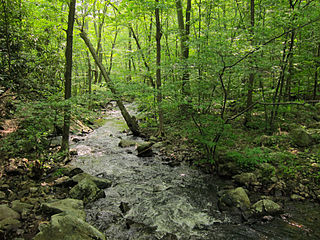
The Northeastern coastal forests are a temperate broadleaf and mixed forests ecoregion of the northeast and middle Atlantic region of the United States. The ecoregion covers an area of 34,630 sq miles (89,691 km2) encompassing the Piedmont and coastal plain of seven states, extending from coastal southwestern Maine, southeastern New Hampshire, eastern Massachusetts, and Rhode Island, southward through Connecticut, New York State, New Jersey, southeast Pennsylvania, Delaware and Maryland.

The Holden Arboretum, in Kirtland, Ohio, is one of the largest arboreta and botanical gardens in the United States, with more than 3,600 acres (1,500 ha), including 600 acres (240 ha) devoted to collections and gardens. Diverse natural areas and ecologically sensitive habitats make up the rest of the holdings. Holden's collections includes 9,400 different kinds of woody plants, representing 79 plant families.

Hamamelis virginiana, known as witch-hazel, common witch-hazel, and American witch-hazel, is a species of flowering shrub native to eastern North America, from Nova Scotia west to Minnesota, and south to central Florida to eastern Texas.
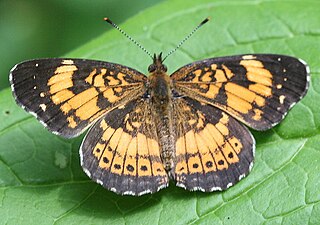
Chlosyne nycteis, the silvery checkerspot, is a species of Nymphalinae butterfly that occurs in North America. It is listed as a species of special concern and believed extirpated in the US state of Connecticut.
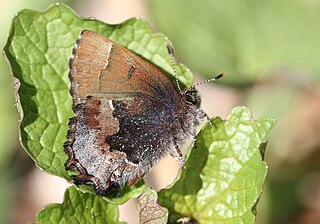
Callophrys henrici, the Henry's elfin or woodland elfin, is a North American butterfly in the family Lycaenidae. In Canada it is found from southern Manitoba to southern Nova Scotia. It has two main groups of populations in the United States; the first is found along the Atlantic Coast and uses various hollies (Ilex) as host plants; and the second is found mainly in the north and the Appalachians where they use redbud as a host plant. Henry's elfin is increasing in New England because of an introduced buckthorn it now uses as a host plant. It is listed as a species of special concern in the US state of Connecticut.

The Appalachian azure is a butterfly in the gossamer wings family Lycaenidae. The male is light blue on the upperwing with a narrow, dark line running along the edge of the forewing. The underwing is chalky white and is dotted with small, pale dark spots. The very back of the hindwing has a row of dark spots running along the edge and contained by a faint zigzagging band. Females are similar to the males but have broad dark wing borders instead of the male's narrow ones. The adult butterfly has a 1.1–1.4-inch (2.8–3.6 cm) wingspan. It is the largest azure in the area.

Callophrys irus, the frosted elfin, is a species of Lycaenidae that is native to North America.
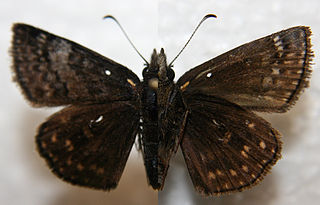
Erynnis brizo, the sleepy duskywing or banded oak duskywing, is a species of Hesperiidae butterfly that occurs throughout North America and is commonly confused with E. juvenalis and E. lucilius. The species is listed as threatened in Connecticut and Maine.
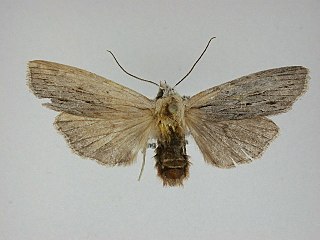
Lithophane lemmeri, Lemmer's noctuid moth or Lemmer's pinion, is a moth of the family Noctuidae. It is found in the eastern parts of the United States and adjacent areas in Canada. It is listed as a species of special concern in the US state of Connecticut. The species was first described by William Barnes and Foster Hendrickson Benjamin in 1929.

Catocala pretiosa, the precious underwing, is a moth of the family Erebidae. The species was first described by Joseph Albert Lintner in 1876. It was included in Catocala crataegi by many authors, but recently it has been revalidated as a distinct species. The subspecies of pretiosa is listed as a species of special concern and believed extirpated in the US state of Connecticut.

Acronicta falcula, the corylus dagger moth, is a moth of the family Noctuidae. The species was first described by Augustus Radcliffe Grote in 1877. It is found in the United States and Canada from southern New England to southern Manitoba and Iowa. Recently seen from Wisconsin, Connecticut, Rhode Island, New York and Michigan. It is reported as rare in Ohio. It is listed as a species of special concern in the US state of Connecticut.
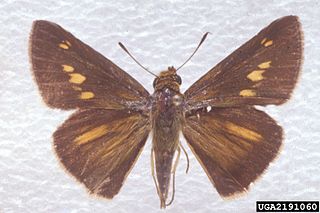
Euphyes dion, the Dion skipper or Alabama skipper, is a species of butterfly of the family Hesperiidae. It is found in scattered populations along the Atlantic coast of North America, from western Massachusetts and south-eastern New York south to north-eastern Florida, west to north-eastern Texas, and north to south-eastern North Dakota, northern Wisconsin, southern Ontario and southern Quebec. It is listed as a species of special concern in the US state of Connecticut.

Symphyotrichum prenanthoides is a species of flowering plant in the family Asteraceae known by the common name crookedstem aster. It is native to northcentral and northeastern North America.
The northeastern interior dry–mesic oak forest is a forest system found in Maine, Vermont, New Hampshire, Massachusetts, Connecticut, Rhode Island, New York, New Jersey, Ohio, Pennsylvania, Maryland, Virginia, and West Virginia. These forests cover large areas at low and middle elevations, typically on flat to gently rolling terrain.
Speranza exonerata, the barrens itame, is a moth of the family Geometridae described by Douglas C. Ferguson in 2008. It is found in Massachusetts, New Hampshire, Pennsylvania and New Jersey. It is listed as threatened in the US state of Connecticut.

Glena cognataria, the blueberry gray moth, is a moth native to North America. It ranges from Florida to Nova Scotia and New Brunswick. Its larvae is hosted on blueberry. The habitat consists of bogs and pine barrens. It is listed as a species of special concern and believed extirpated in the US state of Connecticut.
Chaetaglaea cerata, the waxed sallow, is a species of moth in the family Noctuidae described by John G. Franclemont in 1943. It is found in North America, where it has been recorded from Connecticut, Indiana, Maine, Michigan, Ohio, Ontario, Pennsylvania and Wisconsin.
Papaipema circumlucens, the hops-stalk borer moth, is a species of moth native to North America, where it has been recorded from Illinois, Indiana, Michigan, Missouri, New Hampshire, Ohio, Saskatchewan and Wisconsin. The species was described by Smith in 1899. It is listed as a species of special concern and is believed to be extirpated from the US state of Connecticut.
Photedes inops, common name Spartina borer moth, is a species of moth native to North America. The larvae are hosted on Spartina pectinata, apparently exclusively. It is listed as a species of special concern in the US state of Connecticut.














